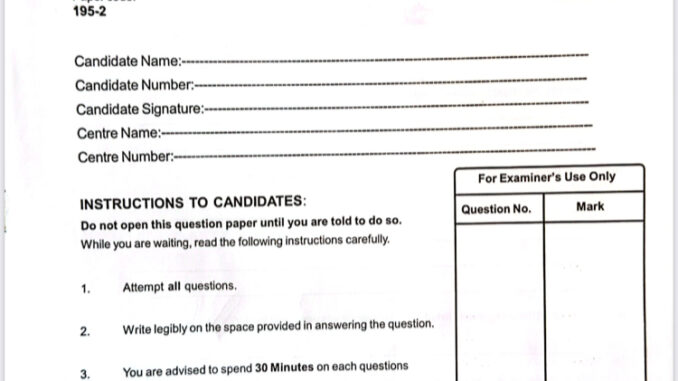
2024 NABTEB GCE AGRIC PAPER 👇
NABTEB GCE 2024 AGRIC PRACTICAL ANSWERS
_ANSWER ALL QUESTIONS_
(1a)
Sprinkler irrigation
(1b)
(i) Pipe network
(ii) Coupler
(iii) Nozzle
(1c)
Nozzle
(1d)
(i) It can be used on a steep slope or undulating landscape
(ii) It is used for efficient control of water
(iii) It can be used to apply liquid fertilizers
(iv) It can be used to apply pesticides
(1e)
(i) High cost of installation
(ii) Poor uniformity of water application during windy periods
(iii) Pipe network obstructs the movement of farm machinery
(iv) It cannot be used where water supply is limited or inadequate
(1f)
(i) A humid environment is created in the irrigated area
(ii) The wet conditions encourage the breeding of pests
READ MORE; NABTEB GCE 2024 Computer Craft Practical
===========================
(2a)
Area = (1/2) x (a+b) x h
Area = (1/2) x (90+70) x 40
Area = (1/2) x (160) x 40
Area = 80 x 40
Area = 3200m²
(2b)
Area per plant = 4×4
Area per plant = 16m²
Number of plants = ?
= (Total area of farmland)/(Area per plant)
Number of plants = 3200/16
Number of plants = 200
(2ci)
I – Ranging pole
II – Arrow/Pin
(2cii)
-Ranging Pole-
(i) Used for marking stations
(ii) Used for making straight lines
-Arrow/Pin-
(i) Used for marking stations
(ii) Used for marking points of intersection
(2ciii)
Regular cleaning after use.
===========================
(3a)
C – Cassava
D – Yam
(3b)
I – Shoots
II – Eyes
III – Roots
(3c)
C – Root Tuber
D – Stem Tuber
(3d)
(i) Cassava Mealybug
(ii) Cassava Green mite
(3e)
(i) Strong rays of the sun
(ii) Attack by yam beetles
(3f)
(i) Seed Yam
(ii) Stem Cuttings
(3g)
Double harvesting is a technique where only part of the yam tuber is harvested, allowing the remaining part to continue growing in the soil. This practice helps the yam plant to continue producing more tuber, which can be harvested later. It allows for a second harvest from the same plant without replanting, maximizing the yield from a single crop.
===========================
(4a)
I – Liver fluke
II – Tick
(4b)
(i) Causes a chronic inflammation of the liver and bile duct
(ii) May cause digestive problems
(iii) Reduction in growth rate of young animals
(iv) Causes loss of weight
(4c)
(i) Sheep
(ii) Cattle
(4d)
(i) Anaplasmosis
(ii) Babesiosis
(iii) Lyme disease
(4e)
(i) Use tick prevention products such as acaricides or insecticides
(ii) Practice pasture rotation to reduce tick habitats
(iii) Maintain good hygiene in animal housing areas
(iv) Regularly inspect animals for ticks and remove them manually.
===========================
COMPLETED

Leave a Reply